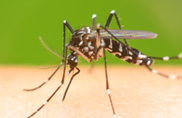
Description:
Mosquitoes belong to the same group as the true flies, diptera. As such, they have a single pair of wings. They typically have long, thin legs and a head featuring a prominent proboscis. Mosquito bodies and wings most often are covered in tiny scales. Adult sizes may range from 3 to 9 mm.
Habits:
Mosquitoes are best known for the habits of the adult females which often feed on blood to help generate their eggs. The lesser-known side is that mosquito adults, males and females, also feed on nectar from flowers. Their immature stages usually are located in standing, preferably stagnant, water. The larvae feed on variety of materials, depending on species. Most consume organic flotsam and tiny aquatic organisms. However, some species are predatory and will consume other mosquitoes. Adult mosquitoes prefer to be most active from dusk until dawn but can become active with sufficient cloud cover or in dark shady areas. They do not prefer to be active in the sunshine since they may desiccate and die.
Defense:
- Mosquito treatment is usually an integrated effort involving source reduction plus the use of chemical control products when needed. Since mosquitoes develop in water, source reduction targets and eliminates water sources favorable for mosquito breeding. While source reduction is the more effective long-term approach to mosquito treatment, the mosquito treatment plan may require using chemical products to supplement source reduction.
- The mosquito treatment plan begins with your pest management professional conducting a thorough property inspection and identifying the kind of mosquitoes causing problems.A pest control professional should be contacted for assistance.